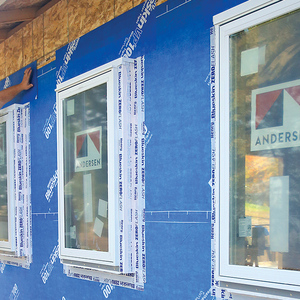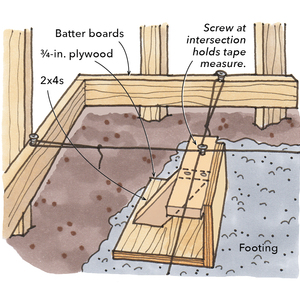O.K., I’m going to turn 120 balusters for a widows walk for my home. The balusters will be 12/4 in thickness. I’m going to use white oak (which will be soaked in a penetrating epoxy sealer and painted). My question is this: Would it be better to use a solid piece of wood or glue two/three sections together? If you suggest gluing sections, what kind of glue? I know this may be pretty basic, but I havn’t done this before and could use your suggestions. BTW, I chose white oak because of previous suggestions on this board. Thanks in advance.
Discussion Forum
Discussion Forum
Up Next
Video Shorts
Featured Story

The Titan Impact X 440 offers great coverage with minimal overspray.
Featured Video
How to Install Cable Rail Around Wood-Post CornersHighlights
"I have learned so much thanks to the searchable articles on the FHB website. I can confidently say that I expect to be a life-long subscriber." - M.K.
Fine Homebuilding Magazine
- Home Group
- Antique Trader
- Arts & Crafts Homes
- Bank Note Reporter
- Cabin Life
- Cuisine at Home
- Fine Gardening
- Fine Woodworking
- Green Building Advisor
- Garden Gate
- Horticulture
- Keep Craft Alive
- Log Home Living
- Military Trader/Vehicles
- Numismatic News
- Numismaster
- Old Cars Weekly
- Old House Journal
- Period Homes
- Popular Woodworking
- Script
- ShopNotes
- Sports Collectors Digest
- Threads
- Timber Home Living
- Traditional Building
- Woodsmith
- World Coin News
- Writer's Digest


















Replies
A glue-up will work just fine, especially if the balusters will be painted. Use epoxy. West Systems has always worked for me, but I'm sure there are others.
Froed
The urethane glues (Gorilla, etc.) are excellent exterior glues. Use sparingly, and wear gloves. Before they kick over completely and set, squeezeout can be cleaned with mineral spirits.
There was something in one of the Gougeon Brothers magazines regarding tests with epoxy and oak. The conclusion (as I remember) was that epoxy did not work well for oak joinery because oak does a great deal of expansion and contraction.
Not sure if it was white oak or not for that test. My understanding has always been that oak is not a very good material for exterior use.
I tried to search their site, but the search function did not work.
I made about half a dozen adirondack chairs out of flatsawn white oak about 4-5 years ago for myself and two of my sisters. All the joints are butt joints, held together with epoxy and stainless steel screws. Mine are outside year round, and every joint is still holding tight. Haven't heard anything to the contrary from my sisters, but they take better care of theirs. I'd like to see the article, though, if you can point me to it.
Red oak isn't suitable for outdoors, but white oak is one of the best woods you can use outside. Both have large pores, the difference is that white oak contains tyloses that block these pores, so it doesn't allow white oak to absorb water like red oak will.
Froed
White oak is an excelent exterior wood! Almost every front door sill is made of the stuff around here(Boston). Most sailing ships used it in hull cunstruction. White oak has a closed cell structure so water can not easily travel up the cells through capilary action. You are going to have to glue it up because it is'nt available thicker than 8/4, can't be dried properly(or perhaps economicly) in thicker sizes. West system is probably your best bet. Remember they are baulstrade and are basicly free floating sticks. Make sure the bottoms are not sitting flat. Give them a birds mouth cut.
Glue-ups are fine, but a lot of work.....I love epoxy, but I'd use resorcinol here. At 120, I bet you could find a remanufacturer and get them solid, milled to your blank size, in white oak or cedar, for less than the cost of all those glue-ups.cabinetmaker/college woodworking instructor. Cape Breton, N.S
One other comment,,,,
You are gonna be really sick of turning when you get done.....
been there...Might consider putting a router on a box to get the basic round before you shape it. Will save a bunch of brain damage. I turn high end pool cues and have a metal lathe with a router on the tool post and use the auto feed...
Bud
You are gonna be really sick of turning when you get done.....
For sure. No auto feed here, but I use a wood lathe with a bed mounted box, surrounding the piece, to guide a router with appropriate base to accomodate the profile. I've found this preferable to any duplicator I've been around even with all the clean-up afterward.PAHS Designer/Builder- Bury it!
oppose the growth rings ,flat sawn if possible . another vote for west system$$$, polyurethane glue (gorilla)¢¢¢... both will work but west system is amazing stuff......
Solid stock is likely to be way more expensive than glued up, but it's worth investigating. It would save you all the time of planing, gluing, clamping, etc., plus the cost of the glue and clamps. If you can get 12/4 at the right price, you could come out ahead.
White oak is great for exterior work because of the high level of tannic acid (tannin) in the wood. Red oak will rot out in a couple of years. I would use resorcinol glue.
http://www.toolsearch.biz/hardware/other/Tools-D/DAP-Waterproof-Resorcinol-Glue,-1-Pt.html
why not go to a hobby store and buy them already turned.
The best employee you can have but you wouldn't want him as a neighbor " He the shifty type"
Good topic,...lots of good comments in here. My 2¢
I am probably going to sell the lathe we have now (Delta 46-700 12" Variable Speed Wood Lathe) and its duplicator attachment because we really need a bigger lathe to turn newels. This one maxes out at 36" (37-1/2" inches if you cheat with it) and we need at times to turn newels that are 4 or 5 feet long if we are going to continue to do that work in house. If after you get through 20 balusters or so you change your mind you can always give me a call to see if I'll sell the duplicator.
View Image
ParadigmProjects.com | Paradigm-360.com | Mac4Construction.com
jerrald-how much for your lathe package? and your thoughts on the lathe ans dup. (whats the brand). thank you ...... bear
."expectations are premeditated resentments"
Good stuff so far...I really appreciate all the suggestions....A couple of comments: (1) I've got a Vega Duplicator that I've used in the past, so I hope this will cut down on some of the tedious repetition. I would like to learn more about using the Router to speed up the process/or in place of the duplicator. Anyone game at trying to explain or point me to a good article that describes the technique. Also, has anyone used the glues from Smith and Company (an epoxy/boat specialty place in the Bay Area)? Just curious. Thanks again.
You mount a U shaped box on the bed of the lathe with the work piece in the center of the U. the U is wide enuff to have your router slide on it and have the bit hit the blank. Then you can at least rough out the blank to round. I use 1/2" end cutting mills in the router. You can also put stops on the box to leave ends square. I have only cut rounds and tapers with a box.
Va Tom might have another way of cutting the shape with the router.
On my metal lathe I have a router attached to the tool post and attach the cross feed to a pattern, and let the auto feed move the router.But obviously that is not possible with a wood lathe.
Bud
Va Tom might have another way of cutting the shape with the router.
Similar. And if you curve the top edges of your U box and reduce your router base to follow the curves you could expand your repertoire. Just make sure you don't tip the router off its reduced base.
When I last did repeated turnings I used a 4 sided box (originally built for spindle turning) bolted to the bed, totally enclosing the blank. Front side had a hole large enough to change the blanks. Top had a slot just wide enough for the finger guide on the router. For the taper I merely shimmed one end of the box. If you don't have a top with a narrow slot, it'd be tough to index and flute.
That was a split-turned table, 26"x26"x19", with glass insert (surrounded by a 3" r. rail) that had one corner leg connected to 4 split-turned tapered "feet" with attached toes. With the exception of the one corner leg, the whole table came off the lathe, 5 turnings split into 12 pieces. Clear as mud? Turnings were quick, the re-assembly took a little longer. As this was a one-off I didn't really need the lathe box, but you never know when something might turn into a small production run.
I know, I need a digital camera. But I do have a lot of fun. And it keeps the audience laughing.
For curved turnings the rail the router rides on has to follow the desired curves and the router base has to be reduced enough to follow the curves. Gotta plan the concave ones carefully to not exceed reasonable expectations for a skinny router base. A little trickier, but works fine. Depending on the radius of the piece, the curved rail has been attached to the top of the aforementioned box.
Fast and accurate.
PAHS Designer/Builder- Bury it!
Edited 11/28/2003 5:00:21 PM ET by VaTom
Gorilla glue and Spanish cedar. Easier to work the cedar, very nice for outside. I use it for trim all of the time. It moves like everything else. Glue up opposing grain. You could also try cypress, but you have to watch the grain for de-laminations. Cypress is generally cheaper than Spanish cedar.
Just my two cents.
Restoring the past for the future.
16/4 stock in white oak is what I'd use..
forget glue ups.. and all the added labor, costs and risk involved with glue ups..
neither system is perfect. glue joints fail and solid stock warps and could check .. make a couple extra and by the time you are done,, you'll know if any will warp bend or check..
Once they are in a rail they won't move around too much.
don't use the cants.. (they are the center cut of logs that goes thru the heart) I wouldn't worry too much about green wood, air dried for a year or so should be OK that's just enough time that most of the movement will have taken place and not so dry as to make cutting all of those too difficult.
I have a vega duplicator that I use to do most of my cutting.. I found that I needed to spend too much time sharpening my chisels and the simple cutter can be touched up in in about a minute compared to spending as much as 20 minutes sharpening my chisels..
I still do the finish cuts with the chisels because trying to sand all of the imperfections the duplicator makes would drive me more insane than I already am.. sharp chisels leave the spindales baby butt smooth..